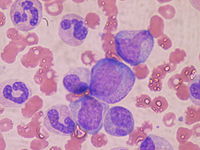Hematopoiesis

* The morphological characteristics of hematopoietic cells are shown as seen in Wright staining, May-Giemsa staining or May-Grünwald-Giemsa staining. Alternative names of certain cells are indicated between parenthesis. cells may have more than one characteristic appearance. In these cases, more than one representation of the same cell has been included. * Together, the monocytes and lymphocytes comprise the granulocytes, unlike the granulocytes (basophiles, neutrophils and eosinophils) that occur during granulopoyesis. * b., n. and e. represent basophilic, neutral and eosinophilic, respectively - as in basophilic promylocyte. [1] The polychromatic erythrocyte (reticulocyte) on the right shows its characteristic appearance when stained with methylene blue or Azure B.
[2] The right erythrocyte is a more accurate representation of its appearance in reality when seen through a microscope.
[3] Other cells that emerge from the monocyte: osteoclasts, microglia (central nervous system), Langerhans cells (epidermis), Kupffer cells (hygado).
[4] For greater clarity, T and B lymphocytes are divided to better indicate that the plasma cell emerges from cell B. Note that there is no difference in the appearance of B and T cells, unless a specific stain is applied.
The hematopoiesis or hemopoiesis (from the gr. αἷμα, -ατος-, 'blood' and ποίησις, 'creation') is the process of formation, development and maturation of blood elements (erythrocytes, leukocytes and thrombocytes (platelets)) from a known common and undifferentiated cell precursor as a multipotent hematopoietic stem cell, clone-forming unit, hemocitoblasto or stem cell.
Stem cells found in the bone marrow in adults are responsible for forming all the cells and cell derivatives that circulate in the blood.
Blood cells are broken down by spleen and liver macrophages. It is also known for its distribution in the blood.
Hematopoietic tissue
Hematopoiesis of the hematopoietic tissue provides the cellularity and tissue microenvironment necessary to generate the different blood constituents. In the adult, the hematopoietic tissue is part of the bone marrow and this is where normal hematopoiesis occurs.
During ontogenesis, the site where hematopoiesis occurs varies, due to different nesting of the hematopoietic tissue. Thus, three sequential phases are verified according to the hematopoietic sites:
- Metablastic phase or megaloblastia: Initial phase, on the trunk peduncle and viteline sac. Both structures have a few millimeters in length, occurs in the third week of embryonic life.
- Hepatic phase: Towards the third month of embryonic life, the liver is sown by stem cells of the viteline sac.
- Medular or myeloid phase: The spleen and the fetal bone marrow present liver stem cell sows.
Concept
Histologists of the 19th century and early 20th century classified blood cells into two categories or lineages based on their presumed place of origin: bone marrow, or lymphoid organs (lymph nodes, spleen, or thymus).
With some corrections —because the supposition of a dual origin of blood cells is not considered valid and it is currently understood that they all have a single and common origin in the bone marrow—, such classification is still valid:
- The...myeloid stripe", it includes the erythrocytes, platelets, granular leukocytes (neutrophiles, basophiles and eosinophils) and monocytes-matrophages. The development of such elements is known as Honeyopoyesis and part of a common precursor stem cell.
- The...Lymphoid stripe", it includes only lymphocytes, which can be of two types: B lymphocytes and T lymphocytes (there is a third type, NK lymphocytes). The development of these cells is called lymphocysis.
Myelopoiesis
Myelopoiesis is the process that leads to the generation, development, and maturation of the myeloid component of blood: erythrocytes, platelets, neutrophils, basophils, eosinophils, and monocytes. Each myeloid type corresponds respectively to a different generative process.
Erythropoiesis
The finite life of erythrocytes, with an average of 120 days, requires their continuous renewal to sustain a constant circulating population. Erythropoiesis is the generative process of erythrocytes.
Thrombopoiesis
Thrombopoiesis involves the processes that end in the formation of blood platelets.
Granulopoiesis
Granulopoiesis is the process that allows the generation of polymorphonuclear granulocytes in the blood: neutrophils, basophils and eosinophils. It is generated from the myeloid line, the first stage in its differentiation is the myeloblast, this differentiates into a promyelocyte that generates the primary azurophilic granulations of the polymorphonuclear ones, this in turn differentiates into a myelocyte that generates specific secondary granulations for each one. Thus, depending on the secondary granules generated, it will become a basophilic, acidic or neutrophilic metamyelocyte. In the development of the neutrophil, the nucleus adopts a band conformation and later becomes a segmented mature neutrophil. Granulopoiesis is characterized by an increase in the nucleus-to-cytoplasm ratio, disappearance of nucleoli, and chromatin condensation.
Monopoiesis
Monopoiesis is the formation of monocytes.
Monocytic series:
Monocytes have a medullary origin, the youngest element being the monoblast. This cell originates the promonocyte, recognizable in the bone marrow, which in its hemoperipheral passage is transformed into a monocyte and finally migrates to the tissues, originating histiocytes and macrophages.
Lymphopoiesis
Lymphopoiesis is the process of hematopoietic development, in which lymphocytes and Natural Killer cells (NK cells) are formed from a hematopoietic stem cell. Each of the cells that are formed (B lymphocytes, T lymphocytes and NK cells) has an independent genesis and maturation process, which culminates in different organs.
The differentiation of lymphocytic cells takes place in the bone marrow (main hematopoietic organ), although the maturation of T and B lymphocytes occurs in different organs: B lymphocytes in the bone marrow (Bone marrow in English), and T Lymphocytes in the Thymus.
Blood plasma
The elements that make up blood plasma originate in different parts of the body:
- the protein component is produced in the liver, includes albumin, proteins involved in clotting and globulins.
- hormones are produced in endocrine glands.
- the aqueous fraction is maintained by the kidney and by the digestive tract.
Plasma also contains inorganic substances such as gases (Oxygen, Carbon Dioxide and Nitrogen), salts, minerals, vitamins and metabolic waste.
Contenido relacionado
Molecular biology
Bromus
Amaryllidoideae
